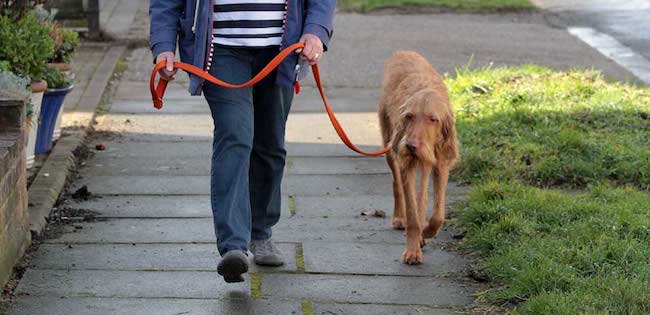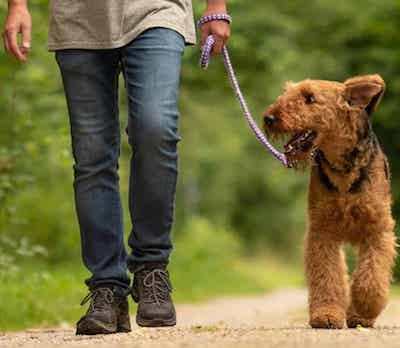Walking with your pooch is always beautiful, but if they are trained properly. A Leash keeps your canine in your control and doesn’t let him go freely outdoors which is abysmal.
Dogs are inquisitive by nature, so they can run into trouble a lot of times with a leash this can be forestalled.
Having said that, leash training a dog is easier said than done, especially if they are older. Older dogs can pick up bad habits quickly so it can prove to be challenging to train them.
But whether they have bad behavior or not—it’s never too late to leash train an older dog.
With right methods, consistency, and patience from Zhou you can easily teach them to walk on a leash.
So here how to train an older dog to walk on a leash.

Teaching an Older Dog to Walk on a Leash
Most individuals think that leash training is next to impossible—but reality couldn’t be far away from the truth.
As a matter of fact, it is just the same as teaching a puppy during his childhood. Now, that doesn’t mean that it will be simply straightforward and simple, you’ll have to work a little bit hard.
Just as teaching the pup, you’ll need to keep your cool and make sure not to get frustrated while teaching your furry friend. But before we hop into all the tips and tricks let’s first make sure the things NOT to do while training an older dog to walk on a leash.
Note: Do you know, how to train your dog to walk without a leash? Get all the information here.
Punishing Techniques
Woah, hold down before you go all busting on the little fella, remember, there is always another option.
And in this case, you’ll have to work with canine psychology—which we will discuss just shortly.
Punishing the dog or using a choke and shock collar will not only divert the message you are trying to instill but also physically damage your pooch.
While this might work, in the long run, the dog will always be scared especially from you and might have different behavioral issues.
To be honest, no one likes to be constrained to do something, and leash walking for one can be easily done without all the violence.
So the simple takeaway here is to never use any sort of punishment, should you decide to do so then there will be hard repercussions.
Running Out of Patience
Being patient and maintaining consistency are the two important aspects to ensure that your Fido can walk with you calmly.
Shouting or yelling at your dog is only going to make things hard.
Remember dogs also learn quickly, but it also depends on the way you are teaching so keeping your cool is important.
Likewise, losing patience will most impact their behavior, and it will be a hard time for them to walk with you on a leash.
Wrong Collar and Leash
Well, maybe all your dog need is more comfortability which he is not getting due to a wrong collar or leash.
Right leash and collar will not make walking more comfortable for your pooch but also enjoyable.
Generally, you should look for collars that are not too tight or loose and leashes that are thin for smaller dogs and thicker for stronger and larger dogs.
Yeah, but you just have to make sure to opt for a short leash to train your older dog, as it will be better for more control.
Read More: Ways to Hold a Dog Leash | Stop Dog from Pulling on a Leash | Train a Dog to Walk on a Leash Beside You
How to Train an Older Dog to Walk on a Leash

Now that you are aware of the don’t’s—let’s get into the psychology of dogs.
Well, what we say “It takes a thief to catch a thief” the same goes for dogs you’ll have to slowly and steadily mold their thinking and mind to obey you.
And for this approach to be successive you will have to maintain consistency and patience as well as not letting frustration get the best of you.
Do you have a puppy at your home? Find out how to teach a puppy to walk on a leash. This would be a great help for you to learn about teaching a puppy to walk on a leash.
Acclimatizing the Collar and Leash
The most common problems pet owners face is that their dog gets super excited watching the leash and lose control before even stepping out.
Let your dog get used to being on the leash and the best way to do this is to introduce him to the leash in your house without going outside. You can place the collar as well as the leash and let him roam (just make sure he doesn’t get tangled up).
Then after a few minutes remove the leash and repeat the same after few minutes.
You can also introduce the collar and leash during mealtime and after-meal walk with your pooch for a few steps and then remove the leash.
Keep repeating this process till he gets used to with the collar and the leash.
The main reason for this is to implant positive habits in your pooch when he sees the leash.
The next problem you’ll face is when you are actually taking your pooch out for a walk, and your dog for one is going to be excited—like literally more excited.
To tackle this, just like the previous one you’ll have to remove the fallacy of leash being associated to walk. Simply put the leash and collar on your pooch and go outside your door wait a few minutes and come back again.
Repeat this till both you and your pooch gets bored. So that he will choose to be calm after you step out of the door.
Sound Cue or Command
Now that your canine is comfortable with leash around, it’s time to teach them a sound cue and command to react.
Basically, you can use commands such as “come” or “heel” to get your things done. Once they do, you will reward them with treats.
For instance, say “come” in a friendly tone when walking on a leash then stop and let him come to you, once he reacts and comes near you walk along with him a few more steps and then reward him.
Repeat this so that as soon as he hears your command he knows that it is reward time.
Gradually, you will decrease the number of treats and increase the walking distance.
As long as you are rewarding him for all the good behavior, the pup will learn faster.
Note: You can also read about how to get a stubborn dog to walk on a leash if you are having a stubborn dog.
Gaining Control
To keep the training as effective as possible it is important to inculcate the idea that you are always in control of the direction, speed, and everything in general.
Now, this doesn’t mean that you have to force it, this can happen naturally with the help of sound cues and commands.
But reaching this state can be challenging and frustrating as your overexcited dog would love to go to the places that pique his interest.
One great method to work with is to steer the direction opposite from where the interest is arising.
Your pooch will not understand this at first but with a rewarding system and commands, he will realize that walking with you is probably the best option.
Always pet him and praise him for all the good behavior, possibly you can also keep treating him as he will expect this at some point.
Leash Pulling and Resisting Walking
Of course, when you are outside this will happen the most but there is a way to deal with that by some tried and tested techniques.
One way to deal with leash pulling is to stand like a tree. So when your pooch pulls the leash, you stand still and don’t move.
Soon he will realize that there is no point in pulling the leash as he cannot go further away.
At that point, you call him and reward him as soon as he reacts to your command and comes towards you. If he still resists to walk and tries to pull in a different direction then another method is to go in the opposite direction.
This way he will have to follow you or standstill, and if he is not following you increase their interest by calling out the command, and once he returns to you, it’s reward time.
Keep praising him and showing him that you are way happy to see him following your commands.
So that it encourages him to perform better.
The deal with the reward system is that it makes them understand that walking calmly beside you is going to reap more rewards, and you will always be in control.
Slowly they will get used to the leash and pulling stuff, but it will greatly depend on your efforts as well as the nature of your pooch.
With time and patience, they will start walking nicely on the leash, till then you will have to keep trying.
Staying Consistent
Lastly, this is the end part—and that is from your side. Make sure to stay consistent with your training.
Likewise, it would be cruel to expect that your pooch will learn within weeks. It may take months so try not to run out of patience.
Make sure not to extend the training sessions rather keep them small and consistent daily.
The simple psychology of dogs to understand is to implement the idea of good behavior.
… And for bad behavior rather than punishing, don’t reward them. If they are pulling and resisting much, stand still or slowly walk away.
Make them come behind you, and then reward them. Keep repeating the process till they get familiarized with the same.
Read More: How to Make a Dog Leash Out of Climbing Rope | How to Make a Paracord Dog Leash Using Cobra Stitch
FAQs About Leash Training Senior Dogs
How to train an older dog to walk calmly on a leash?
Sometimes, old dogs equals young minds, so you will have to train them with love and affection as well as some treats. Basically, you will have to keep repeating the process of walking with them in your house while teaching them some commands like heel and come or sit or stand.
Keep rewarding for all the good behavior and for the pulling make sure to follow the mentioned advice. Slowly your pooch will understand.
What to do if dog refuses to clip on the leash?
If you’re walking a dog for the first time, and it refuses to let you clip on his leash, then it is probably because he is not acclimated with the leash and may be the collar. And for that it is important to keep the leash on him for a few days, like when he is having meal or roaming in your house.
Once he gets used to the leash being on him then you can slowly start walking with him in your house. After that with some commands and the mentioned methods you take him outside the house.
Why won’t my dog walk on a leash?
There are several reasons why dogs resists walking on a leash, one of them would be improper leash training. Other could be due to punishing them. Another reason could be they are not used to being on a leash, the smell and feel of the leash as well as the collar could be uncomfortable for them.
Is it ever too late to train a dog?
Of course not, but if their bad behavior is for years then it can take time to change that habit. As the saying goes “Old habits, Die Hard” so you’ll have to put a little more effort.
Wrapping Up
Now, depending on your effort and consistency as well as the nature of your pooch will decide how long it will take for him to walk nicely on a leash.
But stubborn or not, with right teaching methods and consistency it is easy leash training an older dog.
Given that you’ve figured out how to leash train an older dog, it will take some time and patience from your end for that to successfully happen—and when it does, you both are going to enjoy the most beautiful walks.
In some cases, you might have to go and visit your qualified local trainer.
… But that is rare, and on the off chance that it is the case then take some care for your dog.
Should you have any queries then make sure to ask them in the comment section and do not forget to mention which one of the mentioned tips worked well for you.
That being said, now you get going, your canine has some training left to do.
Also Read:
- What Do You Do If An Off-leash Dog Approaches You While You Are Walking a Dog
- Retrieve A Dog That Has Got Off-Leash
- DIY Dog Leashes: Custom Ideas with Tutorials

Kathryn is a certified animal behaviorist, dog trainer, and a proud parent of four dogs. Having dealt with hyper-active dogs herself, she certainly knows what will work best for your canines. Moreover, her love for pets drives her to get the most reliable products in the market!

